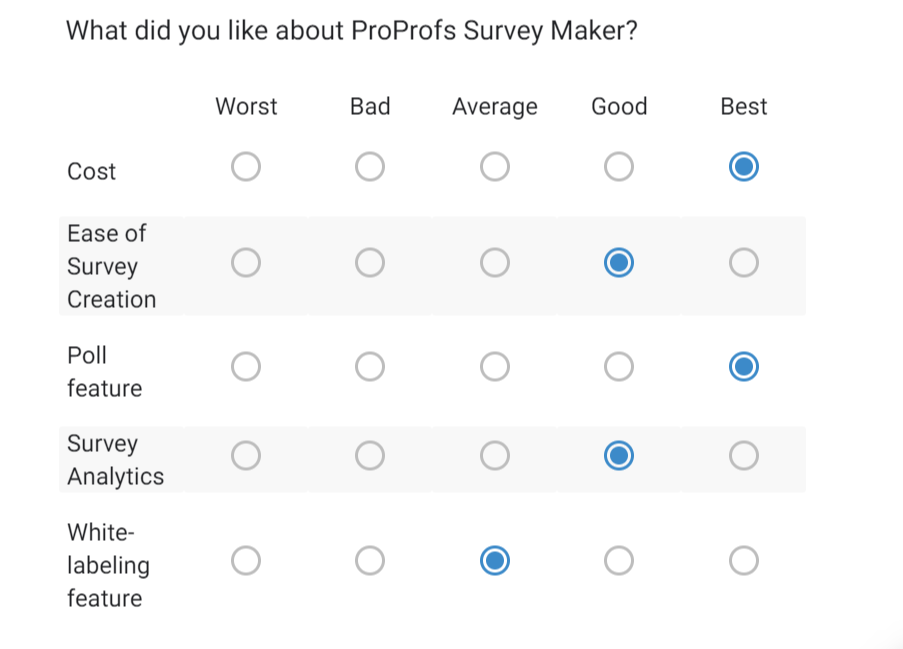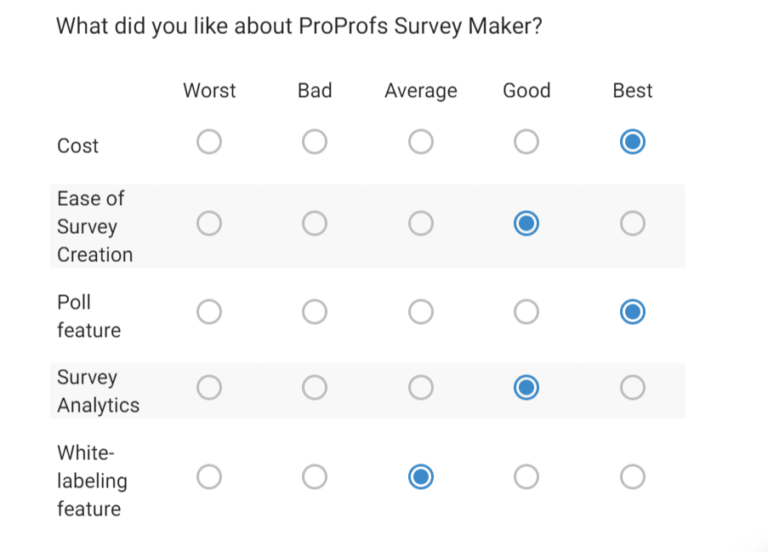A matrix survey question is a combination of all suitable questions regarding a specific subject. Most times your consumers may want to examine and respond to the matrix survey questions with only a quick scan because of the simplicity of the format used for the survey.
In a survey, asking the same question more than once might lead to repetition and boring survey respondents. Longer surveys also suggest longer response times. Studies indicate that a quality survey should take no more than five minutes to complete on average.
That being said, how can we liven up a dull survey with some colour and life? Let’s discuss some important points regarding matrix survey questions in this blog post.
Table of Contents
- What are Matrix Questions?
- Tips for Composing Exceptional Matrix Survey Questions
- How to Create Matrix Survey Questions
- Advantages of Using Matrix Survey Questions
- Disadvantages of Using Matrix Survey Questions
- Different Types of Matrix Survey Questions
- Examples of Matrix Survey Questions
- Flex Matrix Survey Questions
- Sample Matrix Survey Questions
- FAQs About Matrix Survey Questions
- References
- Recommended Posts
What are Matrix Questions?
A matrix question consists of several multiple-choice questions arranged in a row and column grid. While the columns offer a fixed list of response alternatives for each question in the row, the rows pose the questions to the respondents. Often, the response choices are presented as a scale.
Tips for Composing Exceptional Matrix Survey Questions
You must ensure that your survey respondents have a positive experience while crafting matrix questions. They are inspired to participate in additional surveys going forward by this.
Minimum Response possibilities: Keep it to no more than four or five possibilities for responses. This keeps things clear and makes it simple for your respondents to select a response.
Reduce the Length of the Response: Keep the response brief and sweet; avoid going overboard. This guarantees a more comprehensive comprehension of the answers and improves the respondents’ mobile experience.
Don’t Exceed Five Rows: Limit the total number of questions to no more than five rows. Past this point, the matrix awkwardly fills a page. Additionally, your replies may become disinterested due to the unexpected barrage of inquiries.
Avoid Posing Irrelevant Questions: When creating the survey, it may be tempting to include unrelated questions that don’t specifically address a certain good or service. This can mislead your client and cause them to provide false information. Therefore, limit your matrix queries to one subtopic at a time.
Keep Your Language Simple and Jargon-Free: Make sure your target audience can quickly grasp the query by using straightforward language. Avoid using industry jargon as well, as this could confuse your respondents.
Related post: 100+ Product Survey Questions to Improve Customer Experience With Sample Questionnaire
How to Create Matrix Survey Questions
By displaying the questions in a clean column-row format, matrix questions assist you in gathering useful feedback from your clients.
Your clients can quickly decide by quickly skimming the questions on a single screen. This raises response rates and survey participation even more.
You can select from a variety of matrix survey question types, including single-, multiple-, ranking-type, Likert-scale, and others, depending on your needs.
Ensure that the questions are concise, easy to understand, and devoid of technical terms. Additionally, make sure the matrix survey is responsive on mobile devices and limit the number of questions to no more than five per row.
Advantages of Using Matrix Survey Questions
Matrix questions are superior to long response and open-ended survey questions in several ways. from cutting duplication to raising survey response rates.
Space Saving: By employing the row-column style for the matrix survey, many pages of questions and replies are avoided. It is rather easy to fit three or four questions and their answers on one page. When a survey participant sees just one question, they feel at ease.
Reduced Survey Response Time: Questions in a matrix survey have a set format and identical response possibilities for each question. Because of this, it is simple for survey participants to prepare their responses in advance. However, a normal survey questionnaire has multiple-choice answers for every topic, which may further mislead your target audience.
Survey Response Rate Increase: Your respondents will be eager to complete the survey if it has an easy-to-understand single-page style and answer alternatives.
Prevents Monotony: Responding to survey questions back-to-back that ask for both long and short answers might become tedious. A thorough thought process is needed to answer each of these questions.
Read also: Qualitative vs Quantitative Survey Questions | Top 30 Questions to Ask
However, by combining questions about the same subject under a single heading, matrix questions and answers avoid monotony. All that your target audience needs to do is choose similar answer choices and concentrate on the product as a whole.
Disadvantages of Using Matrix Survey Questions
There are issues with data quality, mobile responsiveness, and other aspects of matrix questions.
Straight Lining Effect: While a matrix survey facilitates speedy responses, it is possible for respondents to carelessly choose identical responses for two rows at the same time. Inaccurate responses could cause the survey to become distorted.
Low Data Quality: A matrix with an excessive number of rows or columns may confuse your target audience, which will affect the data quality. They could choose to not participate in the poll at all or provide an inaccurate response.
Probability of Poor Mobile Response: Studies indicate that, on average, about 30% of respondents use their mobile devices to complete surveys. Therefore, matrix questions appear distorted on mobile devices if they are not properly structured and formatted. On mobile devices, this may result in high survey dropout rates.
Different Types of Matrix Survey Questions
Many formats, such as matrix rating scales, text entry types, total types, etc., are available for matrix survey questions. ProProfs Survey Maker is a robust survey design tool that makes it simple to generate these types of questions.
#1. The Single Selection Type
The responder is limited to choosing one column option (response) per question (row option) in this kind of matrix survey question. When there is just one viewpoint on a specific matter, this inquiry is helpful.

Also read: 35+ Post-Webinar Survey Questions You Must Ask for Quality Feedback
#2. Multiple Selection
Respondents to this row question can choose from several column possibilities. When contrasting your brand’s offerings with those of your rivals, use this kind of matrix inquiry.

#3. Likert Measure
A 5- or 7-point Likert scale is used to gauge the opinions of your target audience. It can be classified as very satisfied, extremely dissatisfied, or any combination of these. This kind of matrix inquiry is useful for gathering comprehensive information about a specific good or service.

#4. Bipolar Type
Extreme possibilities are provided at the other end of a bipolar-type matrix survey question. Selecting a response between the two extremes is required of the respondents.

#5. Ranking Type
Respondents to your matrix survey are asked to rank the column options according to their preferences in the ranking type of question. This kind of inquiry is useful when comparing the effectiveness of various goods in your business or finding out what your employees prioritize at work.
Also: 100+ Must Ask Restaurant Survey Questions for Guest Feedback

#6. Comment Type.
Respondents can choose their preferred column (response option) and make more remarks using the comment question type. Employees can decide why money is the most essential factor at work in the example below, and they can also make additional comments and ideas. The employee experience at a company can be greatly enhanced by these extra comments.

Examples of Matrix Survey Questions
It’s easy to create matrix questions, and their versatility allows you to utilize them in a wide range of survey types. Let’s now examine a few distinct kinds of matrix questions and discuss when and how to use them most effectively.
For example, if you own a hotel, you may want to pose the following query to your visitors:
Would you kindly rate your most recent interaction with us?
- a. Completely fulfilling
- b. Quite satisfying
- c. Neither inadequate nor inadequate
- d. Not entirely satisfactory
- e. Completely inadequate
When is the last time you used our products at work?
- a. Each day
- b. In most cases
- c. On occasion
- d. Rarely
- e. Never
How much of the following do you agree with?
- a. I occasionally visit movie theatres.
- b. I’ve never visited a movie theatre.
- c. I have no problem occasionally visiting the movies.
- d. My favourite place to watch movies is at home.
Flex Matrix Survey Questions
Flex matrix is a sophisticated form of matrix question that enables survey designers to incorporate several types of basic questions within the survey. These intricate grid questions urge respondents to concentrate on one issue at a time by combining numerous subtopics.
The Use of a Flex Matrix Question in Surveys
Analysis of competitors: Respondents may be asked to score various brands that are displayed to them as rows. Market analysts can examine how consumers view each brand by analyzing their input. Additionally, they can contrast the relative advantages of several brands.
Questions that are nestled under one another allow survey writers to avoid drafting several questions at once. Market researchers can ask various sub-questions about the same issue because numerous input types are permitted for the columns.
See also: 55+ Pre Event Survey Questions to Ask Your Target Audience
Benefits of Flex Matrix Survey Question
Conserves space: When creating brief questionnaires, a sophisticated grid or flex matrix conserves a significant amount of space.
Improved respondent experience: It takes less time for respondents to read the same set of questions repeatedly. Additionally, when the questionnaire lengthens, respondents perceive it as shorter and are more inclined to finish it. Thus, the rate at which surveys are completed rises.
Details: A variety of data can be gathered by businesses and market researchers for every subtopic. This enables them to obtain a more profound comprehension of the inclinations, selections, and interests of their intended audience.
Flexibility: Survey makers have the option to construct a question or select from a variety of question formats. It provides a special ability for the flex matrix to be applied in the surveys. No other form of question can incorporate different kinds of queries. It simplifies survey creators’ jobs.
Sample Matrix Survey Questions
Every survey is unique. While you might want to collect more detailed feedback for some surveys to gain a deeper understanding of why people act and feel the way they do, you could also want to swiftly obtain as much high-level data as possible to inform your continuing decision-making.
However, we have below a few matrix survey questions examples that might guide you.


See more: 125+ Random Survey Questions | Types and Template

FAQs About Matrix Survey Questions
A matrix question is a kind of closed-ended survey question that gives respondents several options inside a single topic. A matrix question, in contrast to other closed-ended questions, is made up of several distinct questions with a common set of answer choices.
Save space and appear shorter: Even though a matrix question only asks one question, it can appear shorter and save space because it asks respondents to respond to several questions in a single table. This can lower the percentage of survey takers who abandon their surveys.
A matrix is a particular kind of sample; for example, a type of sample can be water, which can encompass a variety of matrix types, such as drinking water and untreated sewage.
A questionnaire is divided into subsets of questions, some of which may overlap, and each subset is then given to one or more separate random subsamples of the original sample. This sampling technique is known as matrix sampling, also often called split-questionnaire sampling.
References
- resources.pollfish.com ____ How to Use Various Matrix Questions
- survicate.com ______ Matrix Questions
- questionpro.com ____ Using flex matrix or advanced matrix question in your surveys
Recommended Posts
- 110+ Post Training Survey Questions With Templates
- 70+ User Experience Survey Questions With Sample Questionnaire
- 250+ Best New Girl Trivia Questions and Answers (Easiest to Hardest)
- Race and Ethnicity Survey Questions | Top 3 Ways to Ask in a Questionaire
- 50+ Frequently Asked Questions About Health with Answers





